Will the Banded Birds Please Stand Up!
CAPE ROYDS, ROSS ISLAND, ANTARCTICA– The major trust of our project is to quantify the vital rates of Adélie Penguins in their changing world, as global climate change proceeds. Vital rates means such things as age of first breeding, proportion of years in which they breed, breeding success each year (number of chicks fledged), survival and emigration. The entire metapopulation, i.e. the four colonies at Capes Royds, Bird and Crozier, plus Beaufort Island, has been increasing in size, though with lots of surges and retreats, over the past decades. At the same time, the colony at Royds, once growing the most rapidly, is now in decline. It all has to do with access to the ocean, which has to do with the extent of sea ice (see our last dispatch).
Every season, we band a lot of chicks at each colony, and in later seasons spend a huge amount of time looking for them when they come back as pre-breeders (teenagers) and then adults. The numbered metal bands are placed around their left wing and this will identify each bird, as well as the year the bird was born and its natal (birth) colony. Once a banded bird begins to breed (its mate or itself laid an egg), we mark its nest with a plastic tag and nail driven into the permafrost. Then we keep track discovering what happens to each banded bird during the course of its lifetime, at least here at the colonies.

Wing Band. Numbered metal bands are attached to the birds when they are chicks. It identifies which colony the bird was born in and what year.
The banding process takes place at the end of the breeding season just before the chicks do their final molt and head out to sea for the winter: 400 chicks each at Royds and Beaufort, 1000 each at Bird and Crozier, each year. We’ve been doing this since 1996 full-scale, with a few banded in 1994 and 1995. So, in total, more than 33,600 chicks banded to date. This banded “sample” of the colony population will serve as an indicator for the movements and survival rate for each colony.
Some of the things we have learned so far are: Adélie penguins do not always return to the colony of their birth and will move from one colony to another to breed and raise their chicks. This is why we call this complex of colonies a “metapopulation”…no colony is independent of the others. What causes penguins to relocate is mainly due to, as we said, access to the ocean, but also the difficulty of finding food or nest stones where there are a lot of penguins. Thus as colonies grow, and resources become harder to come by, penguins are encouraged to move to smaller colonies….just like people!

Beaufort Island Adélie Penguin colony. These grounded icebergs have been here for several years. They are about 1 km off shore and dwarf everything in the area.
Here is the Ross Sea and the coast of Victoria Land in a NASA image taken last week (below). The red stars show the members of the colony cluster that we are investigating. The blue stars show the other Ross Sea Adélie Penguin colonies.
Only the Terra Nova Bay (2 colonies) and Cape Hallet colonies have been thoroughly search for our banded birds, thanks to colleagues in the Italian Antarctic Program (Silvia Olmastroni and friends) and New Zealand Antarctic Program (BJ Karl and friends), who camped at each for several weeks. They found one of our banded birds at each of these three colonies. So, now we know that birds within our metapopulation exchange readily among themselves, but also we know that a few, but not many, intrepid penguins go much farther afield in search of a breeding spot. Tourists with sharp eyes have also noted single banded birds at Franklin Island and at Coulman Island.
At Cape Royds, where we are camped, there are about 2000 nests, so looking for bands takes one person about an hour to complete. However at one of the other colonies in our group, Beaufort Island, there are 60,000 nests and the other day it took four of us four hours to search, and doing so without pause. In fact, we were walking more rapidly in search for bands than is our norm.
In past years there has been open water between Cape Royds and Beaufort so helicopter transport was not possible and band searching could not occur at Beaufort. However, this year the ice is thick so helo transport is possible. From Cape Royds it is a 30 minute helicopter ride to the Island and on this day we stopped to pick up help from Cape Bird: Katie Dugger (co-PI on the project) and Len Doel (volunteer from NZ). Unlike the birds at Cape Royds, the Beaufort Island birds walk less than one mile to open ocean. Why then do the Cape Royds birds make the 50 mile trip when they could nest at Beaufort? We’ve given some hints to the answer, but this is a question for another day.
To establish a breeding colony, Adélie Penguins need ice-free land with a supply of small rocks to build their nest. Beaufort Island has a large beach area with plenty of rocks, but also always easy access to the ocean. So this colony is larger than Royds.
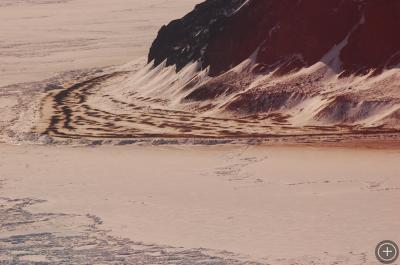
Beaufort Island Colony. A large, ice-free beach with lots of small rocks. The brown areas are where the penguins are. This colony has about 60,000 nests.
Searching for bands requires binoculars and a good eye as you walk along the nesting areas. When we found a banded bird at Beaufort we recorded its number and whether it is on a nest, alone or paired and if the nest has eggs we record the location using a GPS.

Searching for bands. It takes patience and good binoculars to find the banded birds in these large groups.
Color anomalies are rare in penguins, but with a colony this size there is bound to be one, today we found a blond penguin. Its color does not seem to affect its ability to survive.
A good days work; about 80 banded or known age birds were identified representing all four colonies of birth, Cape Crozier, Cape Royds, Cape Bird and of course Beaufort Island. The vast majority of banded birds were banded as chicks at Beaufort. We found 5 that were hatched and banded at Cape Royds. In another 7-10 days we will visit Beaufort Island again, because by then all the females will have replaced their mates on the nests. Thus, we’ll probably find another 80 banded birds who were not there a few days ago.


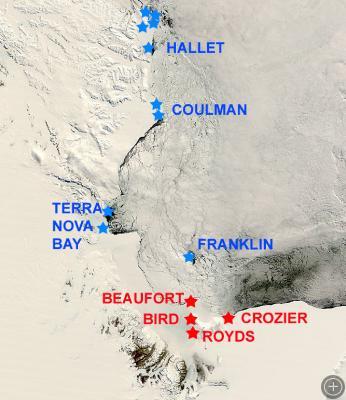
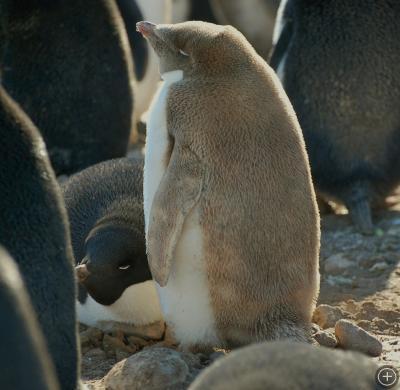
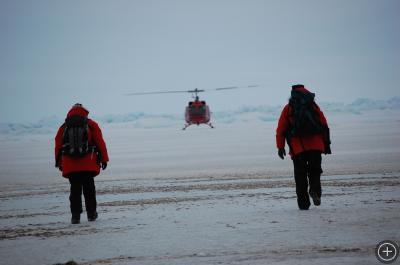

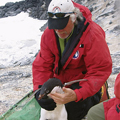

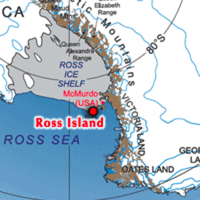





Thank you for your wonderful works with the penguins. I love the blond penguin and am glad to know that the rest of the colony didn’t mind its coloring.
I discovered this site after attending a conference about the Arctic and Antarctica at Barnard College last week. The images are truly amazing.
Thank you. Happy Thanksgiving.
Thanks very much for your interesting post. Will be back in the future.